JavaScript is a modern general-purpose programming language. Its application is not limited to web browsers. It was created with an eye to integration into any applications and with the ability to execute scripts. JavaScript was supposed to be the scripting language for Netscape. At first it was called Mocha, and then LiveScript. It received its current name in December 1995. At the initiative of experts from Netscape JavaScript was standardized by ECMA. 
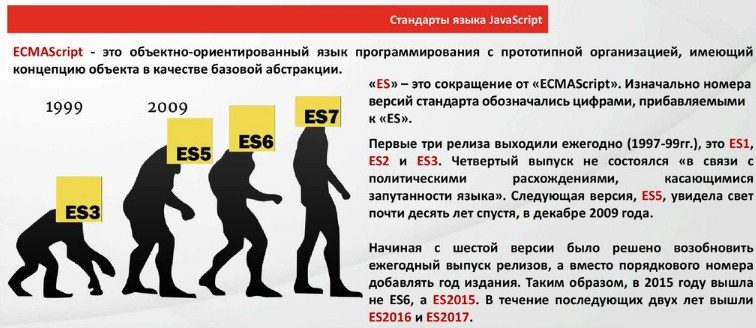
Features and limitations of JavaScript
Since its first implementation, JavaScript has come a long way. Now you can use it to create applications, work in a browser with machine learning (ML) and AI models. Server-side JavaScript (node.js) is allowed. The main features of the language in the browser:
- allows you to work with CSS and HTML (changing, adding, deleting information);
- provides interaction with users on the page (keystrokes, clicks, moving the mouse cursor);
- used to send requests to the server, download/upload files (AJAX JS technology);
- works with cookies.
Restrictions:
- active in an open tab, no access to other open tabs;
- if JS didn’t open a browser window, it won’t be able to close it;
- there is no way to hide the source code of the page;
- no access to system functions of the OS.
It is connected in two ways: through the code on the page and through an external file. In the first case, you should specify <script>//Program body</script>. The code from the external file is included with the command <script src=”name.js”></script>
JavaScript is the best choice for teenagers and beginner programmers. Its main advantage is its prevalence. Supported in all browsers, on all operating systems, mobile devices, personal computers. JavaScript applications work without first being installed on users’ devices. If there is a desire that anyone can use the created module, then JS is a worthy alternative. For example, you need to test. How can I make my test questions visible to other people? Everything is very simple. If JavaScript is chosen to create the code, and an ordinary site is chosen for distribution, the problem will disappear by itself.
The popularity of JavaScript is due to a large number of advantages:
- Essential for web development. Scripts are supported by all popular browsers, integrated with layout and server side (backend).
- Developed ecosystem. There are a large number of ready-made solutions in the public domain.
- Rationality and ease of use.
- High level of usability.
- Ease of learning. You get used to the syntax quickly.
The language also has a number of shortcomings, which, if desired, can be circumvented.
- The need for additional frameworks, libraries . Choosing the right tools is not an easy task. It is possible to understand whether the selected library is suitable for solving a particular problem only after preliminary study of it.
- Careless handling of variables, data types . A minor typo can break the entire program. For example, var Number = 100; Number = Numbe + 1; The script will report the presence of a typo only during the development of the program code. A similar problem will arise if the programmer confuses the register. One more example. The programmer decided to write a number to a variable that already contains a string. There will be no error message in this case. But the result will be far from expectations. You can avoid the problems listed above by using code editors. The most popular option is Visual Studio Code.
- Not suitable for developing network applications (software responsible for the correct operation of enterprise computer networks).
- JavaScript is a free scripting language . Therefore, it will not be difficult for experienced programmers to embed malicious code into it. Today, one of the most common types of attacks is cross-site scripting using JavaScript. For example, XSS attacks are a type of attack that injects malicious code into Internet systems, replaces hidden / visible links, forcing them to give out changed data, and displays their own ads on a damaged site.
https://articles.opexflow.com/programming/kak-stat-programmistom-s-nulya.htm To simplify complex tasks and perform common tasks, it is recommended to use JavaScript libraries, which are collections of ready-made methods and functions. There are a lot of libraries for JavaScript created. Some of them are designed to solve specific problems, such as processing forms or calculating mathematical functions. Others contain the most common widgets for creating full-fledged Internet applications using Ajax technology. Experienced developers using ready-made libraries can save a lot of time. And beginners will have the opportunity to implement projects that they are not yet able to write on their own.
Demand for the language
The popularity of JavaScript among developers is confirmed by international rankings. According to PYPL, he is one of the top three.
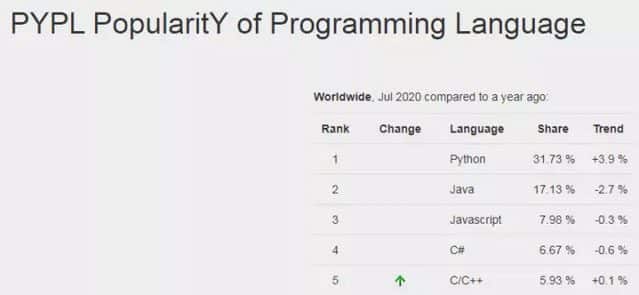
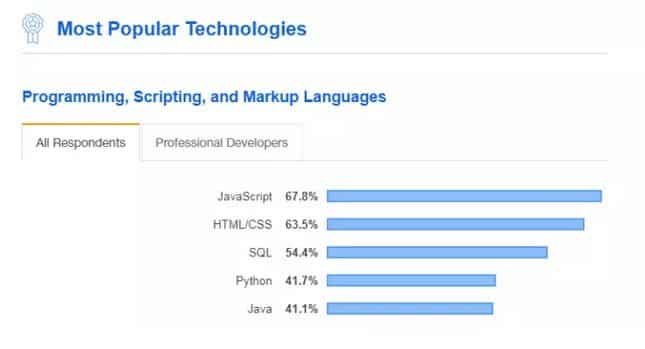
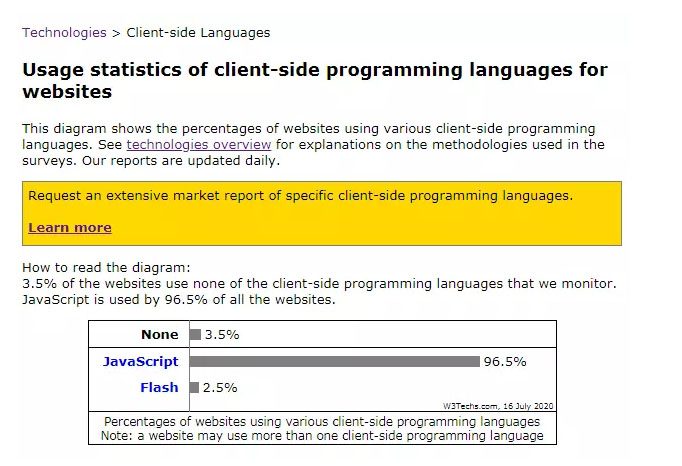


JavaScript and the main aspects of its use
Before learning the syntax of a language, you should understand its main purpose. Most often, JS is used when it is necessary to make a browser-based application, to give the Internet resource more “mobility”.
- Dynamic pages on websites . Using JavaScript, you can create tooltips, various animated effects. The code is embedded in the page. The script works directly in the user’s browser. JS, CSS, HTML – a sufficient set of skills for a modern front-end developer.
- Games, web applications . For example, the Gmail client, Google Maps are made with JS. To create a walker, you can use HTML5, JS and a ready-made library.
- Browser Extensions . You can write your own activity counter or a program that will keep track of how much time is spent performing certain actions.
- Web server . In the backend environment, JS competes with Python, PHP, and other languages. The main advantage is the ability to develop the client and server parts in the same language. To create a JS backend, developers use the Node.js engine.
- Desktop (desktop applications) .
- Mobile Applications . This is not the most common use of JavaScript. But it has a place to be, if only because JS allows you to create cross-platform applications. To do this, you can use the Ionic, React Native, PhoneGap frameworks.
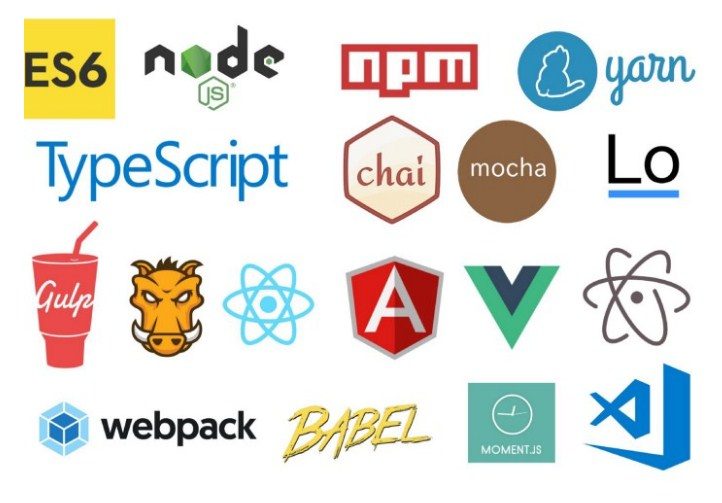
- transfer learning;
- previously trained model;
- developing your own model.
Consider, as an example, the use of a previously trained model. Suppose we need to develop a website that will analyze pictures and select those that show a cat. MobileNet is a popular image classifier. It is available in trained model format from Tensorflow.js. The following code will appear on the site:
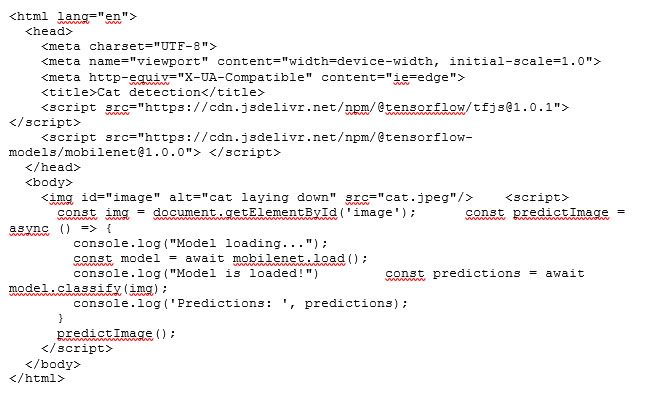



The feasibility of learning JavaScript in 2022 – development perspectives
JavaScript is the foundation on which all front-end web development is based. With it, you can perform various actions and intercept events. For example, a user clicks on a menu item on a website. The click command worked. Next, a specific function is called: changing the color of the active element, activating the modal window. JavaScript is used to make the pages of the site more interactive, to allow visitors to interact with various constructive elements. With JavaScript, you can add a huge number of useful features to a web page. Using only HTML, CSS and JS, developers can create various functional applications. For example, a map that will be updated in real time, online games. Look at the popular site Pinterest. Here, JavaScript is used to the fullest to create a friendly user interface. In addition, JavaScript is the most popular programming language in the world. And regardless of career aspirations, this very useful language should be learned. The language can be mastered not only by novice web programmers, but also by schoolchildren for general development. This is facilitated by the intuitive understandability of the code, the rationality of the language, and the simplicity of the syntax. JavaScript is a language that has the following features: This is facilitated by the intuitive understandability of the code, the rationality of the language, and the simplicity of the syntax. JavaScript is a language that has the following features: This is facilitated by the intuitive understandability of the code, the rationality of the language, and the simplicity of the syntax. JavaScript is a language that has the following features:
- Case sensitive. There is a huge difference between Func() and func() functions.
- Presence of built-in operations and objects.
- The need for a semicolon after operators.
- Insensitive to spaces. You can use a different number of indents to format the code.
JavaScript – complete JS course for beginners, video tutorial for learning from scratch and for more experienced developers: https://youtu.be/CxgOKJh4zWE
JavaScript is a scripting language. A script is a program code that does not need to be pre-processed before being launched. The code is processed by the browser engine during page loading.
There are a number of basic guidelines that can greatly simplify the process of learning the JavaScript language.
- First of all, you need to get acquainted with HTML and CSS. You should not start creating sites, applications, forms and other things for the Internet without knowing the basics.
- Study new literature. Information technology is developing, so do not neglect updates.
- Try to write all parts of the program yourself. If you had to borrow someone else’s code, carefully study each line.
- Use debugging. The most important skill of any experienced programmer is to quickly find errors and shortcomings.
- Write beautiful code. Do not ignore formatting standards. Of course, the number of spaces or indents will not affect the quality of the script, but it will become more understandable and readable. Here is a snippet of bad code.
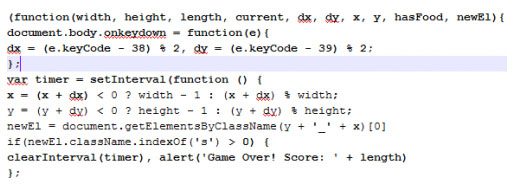
- Try to comment on important actions.
JavaScript is a language that has become widely used in the web programming environment. It has absorbed the capabilities of functional and object-oriented languages. But do not forget that language is a developer’s tool, and the most important thing in writing code is thought.
Useful information for professional front-end developers
React is a JavaScript library. Recently, it has become the standard for front-end development. This is good news for cross-platform developers. React Native has the following benefits:
- Efficient and smart rendering that only redraws components when necessary (if state changes).
- Intuitive and very simple philosophy for declaring states, views. The code becomes readable, beautiful and easy to debug.
In simpler terms, React bridges the gap between JS and HTML. React JS fundamental course from A to Z: https://youtu.be/GNrdg3PzpJQ Few people write pure CSS these days. It has become a necessity for professional front-end developers to learn languages like Less or Sass. Another recommendation is to explore the available ways to build responsive pages. This is due to the large number of form factors of a wide variety of devices (tablets, smartphones, PCs, and so on). There are many JS and CSS libraries available that easily handle this kind of task. Most of them are based on Google’s Material Design guidelines. There are related libraries and topics that you should pay attention to:
- for JSON Web Token authorization;
- for modular Webpack build;
- for data sampling and work with Redux, Relay, Flux streams.
A large number of libraries are also available for optimizing the level of performance, debugging, and managing created projects. Today, in order to become a popular and effective front-end developer, one should study not only the fundamentals, but also be able to choose / apply the achievements of other specialists, which are designed in the form of libraries / frameworks. With their help, the workflow will go much faster.




J’aiemerais une formation complète avec vous su JavaScript à partir d’un cas concrêt
Merci